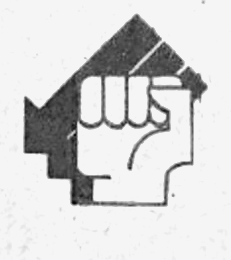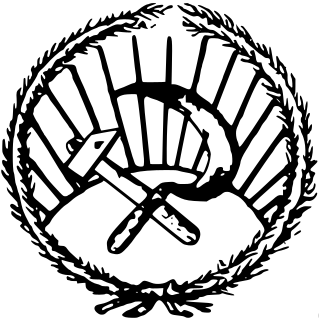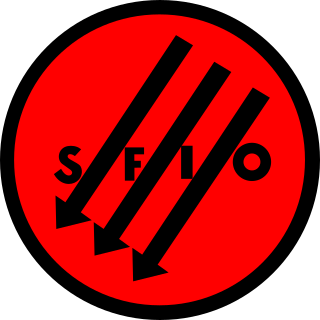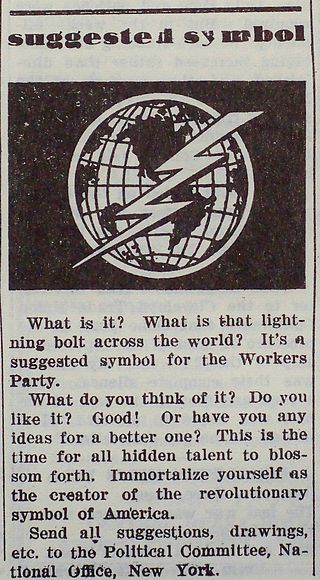
Trotskyism is the political ideology and branch of Marxism developed by Ukrainian-Russian revolutionary Leon Trotsky and some other members of the Left Opposition and Fourth International. Trotsky self-identified as an orthodox Marxist, a revolutionary Marxist, and Bolshevik–Leninist, a follower of Marx, Engels, and 3L: Vladimir Lenin, Karl Liebknecht, and Rosa Luxemburg. He supported founding a vanguard party of the proletariat, proletarian internationalism, and a dictatorship of the proletariat based on working-class self-emancipation and mass democracy. Trotskyists are critical of Stalinism as they oppose Joseph Stalin's theory of socialism in one country in favour of Trotsky's theory of permanent revolution. Trotskyists criticize the bureaucracy and anti-democratic current developed in the Soviet Union under Stalin.

The Fourth International (FI) is a revolutionary socialist international organization consisting of followers of Leon Trotsky, also known as Trotskyists, whose declared goal is the overthrowing of global capitalism and the establishment of world socialism via international revolution. The Fourth International was established in France in 1938, as Trotsky and his supporters, having been expelled from the Soviet Union, considered the Communist International as effectively puppets of Stalinism and thus incapable of leading the international working class to political power. Thus, Trotskyists founded their own competing Fourth International.

The Workers and Peasants' Socialist Party was an ephemeral socialist organisation in France, formed on June 8, 1938 by Marceau Pivert. Its youth wing was the Workers and Peasants' Socialist Youth.
The Popular Front was an alliance of French left-wing movements, including the communist French Communist Party (PCF), the socialist French Section of the Workers' International (SFIO) and the progressive Radical-Socialist Republican Party, during the interwar period. Three months after the victory of the Spanish Popular Front, the Popular Front won the May 1936 legislative election, leading to the formation of a government first headed by SFIO leader Léon Blum and exclusively composed of republican and SFIO ministers.

Grandizo Munis was a Spanish politician.
The International Revolutionary Marxist Centre was an international association of left-socialist parties. The member-parties rejected both mainstream social democracy and the Third International.
The Internationalist Communist Party was a Trotskyist political party in France. It was the name taken by the French Section of the Fourth International from its foundation until a name change in the late 1960s.

Marceau Pivert was a French schoolteacher, trade unionist, socialist militant, and journalist. He was an alumnus of the École normale supérieure de Saint-Cloud.

Albert Goldman (1897–1960) was a Belorussian-born American political and civil rights lawyer, closely associated with the American communist movement. Goldman broke with the mainline Communist Party, USA in 1933, joining the Trotskyist opposition, in which he would be a leading participant for the better part of the next two decades. Goldman is best remembered as a defendant and lead defense attorney in the 1941 Smith Act prosecution of the leadership of the Socialist Workers Party.
Edward Hugo Oehler (1903–1983) was an American communist.
The Fieldites were a small leftist sect that split from the Communist League of America in 1934 and known officially as the Organization Committee for a Revolutionary Workers Party and then the League for a Revolutionary Workers Party. The name comes from the name of its leader B. J. Field.
The International Committee of the Fourth International (ICFI) is the name of two Trotskyist internationals; one with sections named Socialist Equality Party which publishes the World Socialist Web Site, and another linked to the Workers Revolutionary Party in the UK.
Entryism is a political strategy in which an organisation or state encourages its members or supporters to join another, usually larger, organization in an attempt to expand influence and expand their ideas and program. If the organization being "entered" is hostile to entrism, the entrists may engage in a degree of subterfuge and subversion to hide the fact that they are an organization in their own right.

The Left in France was represented at the beginning of the 20th century by two main political parties, namely the Republican, Radical and Radical-Socialist Party and the French Section of the Workers' International (SFIO), created in 1905 as a merger of various Marxist parties.

The French Section of the Workers' International was a political party in France that was founded in 1905 and succeeded in 1969 by the modern-day Socialist Party. The SFIO was founded during the 1905 Globe Congress in Paris as a merger between the French Socialist Party and the Socialist Party of France in order to create the French section of the Second International, designated as the party of the workers' movement.

The Workers Party of the United States (WPUS) was established in December 1934 by a merger of the American Workers Party (AWP) led by A.J. Muste and the Trotskyist Communist League of America (CLA) led by James P. Cannon. The party was dissolved in 1936 when its members entered the Socialist Party of America en masse.

The Revolutionary Workers League (RWL) was a radical left group in the United States, lasting from 1935 through 1946. It was led by Hugo Oehler and published The Fighting Worker newspaper.

James Patrick Cannon was an American Trotskyist and a leader of the Socialist Workers Party.

Pierre Frank was a French Trotskyist leader. He served on the secretariat of the Fourth International from 1948 to 1979.
The Socialist Workers Party (SWP) is a communist party in the United States. Originally a group in the Communist Party USA that supported Leon Trotsky against Soviet leader Joseph Stalin, it places a priority on "solidarity work" to aid strikes and is strongly supportive of Cuba. The SWP publishes The Militant, a weekly newspaper that dates back to 1928. It also maintains Pathfinder Press.












